When SMART Storage Systems (now SanDisk) announced the Optimus SAS SSD months ago, their pride in design, build and manufacture was clear, much like a proud parent parading their first-born. The key from SMART’s perspective is being able to better understand NAND to drive enterprise-grade endurance out of consumer grade MLC NAND. The Optimus however goes a step further, pressing SMART’s engineering skills by leveraging a custom firmware build on top of a custom controller, giving them even more control over the SSD as a system. The results are impressive for a mainstream enterprise SSD – endurance of 10 full random drives writes per day for five years, along with up to 500MB/s sustained read/write throughput. The specs alone don’t tell the whole Optimus tale however. In the intro to this review we’ve already called the Optimus a mainstream enterprise SSD, which is largely based on the NAND profile. That may be a mistake however. While the Optimus may present SLC-like endurance with MLC NAND, it’s also capable of presenting SLC-like performance, with MLC NAND. In some cases it even bests SLC drives, which we’ll dive into more below.
The Optimus complements SMART’s other enterprise offerings designed around the SandForce controller. SMART maintains the dual line of products to appeal to the varying workload needs and budgets of the enterprise buyer. The Optimus family is certainly their flagship, with a variety of offerings depending on the endurance need of the use case. The Optimus carries a standard 28% over provisioning (OP) and 10 drive writes per day (DWPD), where moving upstream the Optimus Ultra offers 71% OP and 25DWPD and the Optimus Ultra+ brings in 156% OP and supports 50 DWPD, all with standard MLC NAND.
The OP plays a big role in endurance, but that’s not the only trick SMART brings to the table. SMART has developed a series of technologies that when coupled together address the Optimus endurance needs, but also performance and data protection. Generally speaking these fall under the Guardian Technology umbrella that consists of FlashGuard, DataGuard and EverGuard. Collectively Guardian Technology not only provides the endurance and flash handling algorithms and methodology, but it also includes full data path protection and power fail protection. The Optimus also offers enterprise demanded features like AES 256-bit encryption, TGC enterprise compliance, T-10 DIF support and five year warranty. The Optimus comes in 200GB, 400GB and 800GB in the standard 9.5mm 2.5″ SAS form factor. A 1.6TB Optimus is also available in a 15mm drive height.
SMART Storage Systems Optimus SAS Specifications
- Capacities
- 200GB – TXA2D20200GA6001
- 400GB – TXA2D20400GA6001
- 800GB – TXA2D20800GA6001
- 1.6TB – TXA2D21600GA6001
- Sustained Read/Write: 500/500 MB/s
- 1GB/s sustained read Wide Port
- Random Read/Write 100K/50K IOPS
- 6Gb/s SAS Interface
- Interface Ports Dual/Wide
- Sector Sizes: 512, 520, 528 byte
- Data Reliability 1 unrecoverable error in 1017 bits read
- Endurance: 10 full random drive writes/day
- Power Fail Recovery: Backup Power Circuitry
- Data Path Protection: DataGuard, T-10 DIF
- Warranty 5 years
- Security TCG Enterprise Compliant
- Encryption AES 256-bit
- Power: Active (Typ) 7 W
- Shock: 1000 g half-sine, 0.5 msec, 3 shocks along each axis, X, Y, Z, in each direction
- Vibration: 2.17 g rms, 7-800 Hz
- Operating Temperature: 0° C to 70° C (internal)
- Storage Temperature: -40° C to 90° C
- Humidity: 5% to 95%, non-condensing, relative humidity
- Altitude: 5486.4 m [18,000 ft]
- Length 100.20 mm x Width 69.85 mm x Height 9.50 mm (1.6TB 15mm)
Design and Build
The SMART Storage Systems Optimus is an enterprise-targeted 9.5mm SSD with a SAS interface. Unlike most of its competitors, excluding the P300 which is also 9.5mm, the Optimus follows this smaller form-factor instead of the larger 15mm Z-height (except the 1.6TB Optimus which is 15mm) commonly found amongst enterprise flash or spindle drives. This gives it the best foot forward as many enterprise platforms start shifting their focus from traditional 2.5-inch hard drive form factors, to slimmer SSD-oriented designs.

The case around the Optimus is CNC-machined alloy that fits perfectly in all systems we mounted it in. Being CNC-machined also gives it an advantage when it comes to internal structure, as SMART can design the case to fit tightly around circuit board components to act as a massive thermal conductor. The entire SSD has a good amount of substance in its weight, without being as heavy as some of its 15mm Z-height brethren.

A front view of the Optimus shows its SAS interface, which is dual-port compatible, is rated for 6.0Gb/s connectivity. No service pins or additional connectors are visible from the front; although the rear does have an opening that isn’t being utilized in the sample we were given.

Opening the Optimus is fairly simple as far as most enterprise SSDs go. You simply remove four standard-sized Phillips head screws and separate the top and bottom covers. Inside we find a carefully machined top and bottom cover, which help draw heat away from important components such as the NAND, power regulators, capacitors, and controller.

At the heart of the SMART Storage Systems Optimus SSD is a custom controller running optimized SMART firmware coupled with SMART’s Guardian Technology. This combination is what drives 10DWPD endurance out of consumer MLC Toshiba NAND. Our 512GB raw, 400GB usable SSD included Toshiba MLC Toggle NAND (TH58TEG8D2HBA8C) which we last spotted inside our review of the consumer-oriented Corsair Performance Pro. This NAND is then cached with Micron RAM.

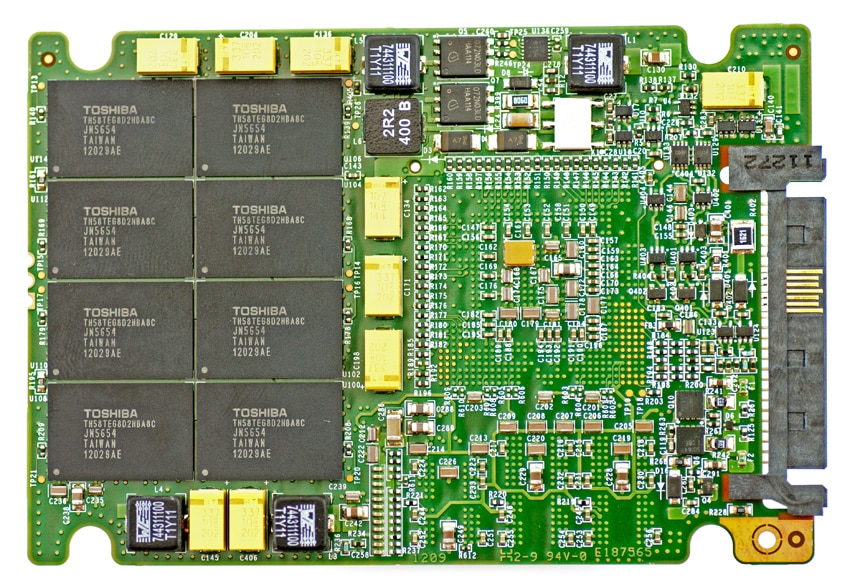
Testing Background and Comparables
Our 400GB SMART Storage Systems Optimus uses a custom controller and Toshiba MLC NAND with a SAS 6.0Gb/s interface. The comparables are listed below and include exclusively SLC-based drives. As becomes evident below, including like-spec’d MLC or eMLC enterprise SSDs would have thrown the scale for our charts far out of whack and wouldn’t do the Optimus justice as showing it’s performance against SLC-based drives is more relevant.
Comparables for this review:
- Micron RealSSD P300 (100GB, Micron 88SS9174 controller, Micron 34nm SLC NAND, 6.0Gb/s SATA)
- SanDisk Lightning LB 406S (400GB, Pliant PTHEMI2-1VO controller, Micron 34nm SLC NAND, 6.0Gb/s SAS)
- Hitachi Ultrastar SSD400S.B (400GB, Intel EW29AA31AA1 controller, Intel 25nm SLC NAND, 6.0Gb/s SAS)
- Toshiba MKx001GRZB (400GB, Marvell 88SS9032 controller, Toshiba 32nm SLC NAND, 6.0Gb/s SAS)
All enterprise SSDs are benchmarked on our enterprise testing platform based on a Lenovo ThinkServer RD240. The ThinkServer RD240 is configured with:
- 2 x Intel Xeon X5650 (2.66GHz, 12MB Cache)
- Windows Server 2008 Standard Edition R2 SP1 64-Bit and CentOS 6.2 64-Bit
- Intel 5500+ ICH10R Chipset
- Memory – 8GB (2 x 4GB) 1333Mhz DDR3 Registered RDIMMs
- LSI 9211 SAS/SATA 6.0Gb/s HBA
Enterprise Synthetic Workload Analysis
Flash performance varies throughout the preconditioning phase of each storage device. Our enterprise storage benchmark process begins with an analysis of the way the drive performs during a thorough preconditioning phase. Each of the comparable drives are secure erased using the vendor’s tools, preconditioned into steady-state with the same workload the device will be tested with under a heavy load of 16 threads with an outstanding queue of 16 per thread, and then tested in set intervals in multiple thread/queue depth profiles to show performance under light and heavy usage.
Preconditioning and Primary Steady-State Tests:
- Throughput (Read+Write IOPS Aggregate)
- Average Latency (Read+Write Latency Averaged Together)
- Max Latency (Peak Read or Write Latency)
- Latency Standard Deviation (Read+Write Standard Deviation Averaged Together)
Our Enterprise Synthetic Workload Analysis includes four profiles based on real-world tasks. These profiles have been developed to make it easier to compare to our past benchmarks as well as widely-published values such as max 4K read and write speed and 8K 70/30, which is commonly used for enterprise drives. We also included two legacy mixed workloads, the traditional File Server and Webserver, each offering a wide mix of transfer sizes.
- 4K
- 100% Read or 100% Write
- 100% 4K
- 8K 70/30
- 70% Read, 30% Write
- 100% 8K
- File Server
- 80% Read, 20% Write
- 10% 512b, 5% 1k, 5% 2k, 60% 4k, 2% 8k, 4% 16k, 4% 32k, 10% 64k
- Webserver
- 100% Read
- 22% 512b, 15% 1k, 8% 2k, 23% 4k, 15% 8k, 2% 16k, 6% 32k, 7% 64k, 1% 128k, 1% 512k
Starting with our first preconditioning workload with 100% 4K random activity, the SMART Optimus starts off with a slower burst rate, similar to the Toshiba eSSD, but as the other drives quickly drop off the Optimus takes a commanding lead over its SLC-competitors.
Switching our focus to latency in our full-saturation preconditioning stage, the Optimus has the fastest response times by far over the duration of our 100% random 4K workload.
As we shift focus to peak latency in the 4K preconditioning workload, the SMART Optimus maintains the lowest maximum responses, which is very unique compared to other MLC or even eMLC products.
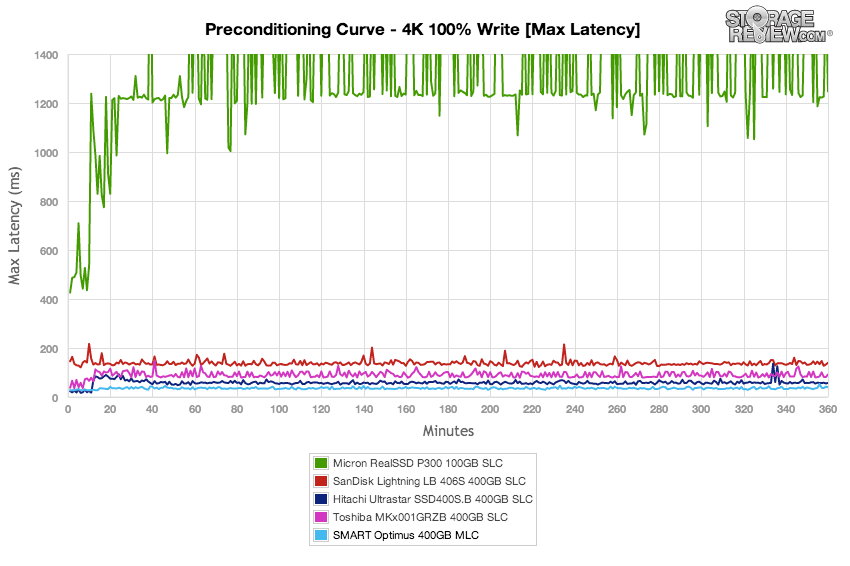
Another view at the responsiveness over time in our 4K preconditioning test shows the Optimus maintained very consistent response times over the entire duration of the test… the lowest out of the entire group.
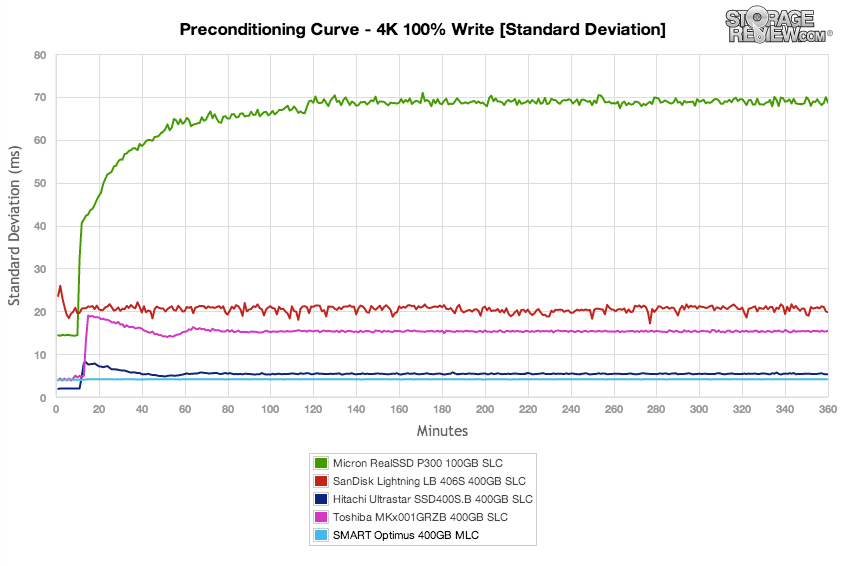
After the preconditioning process finished, the SMART Optimus came in with the highest average 100% 4K random throughput in both read and write activity. It measured 92,698 IOPS 4K random read and 34,778 IOPS 4K random write, well above most drives in both categories.
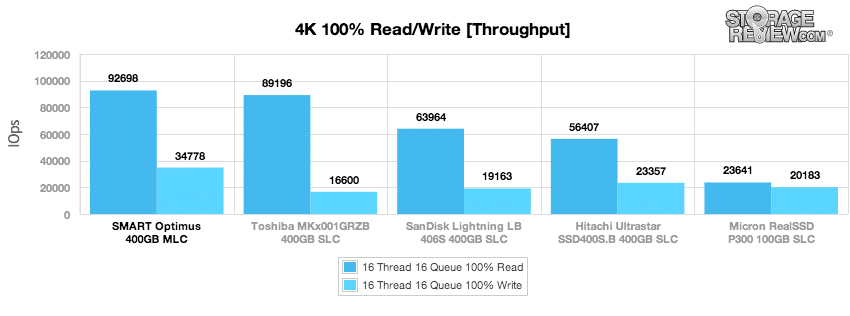
With its incredibly fast throughput performance, the SMART Optimus also offered the lowest average latency.
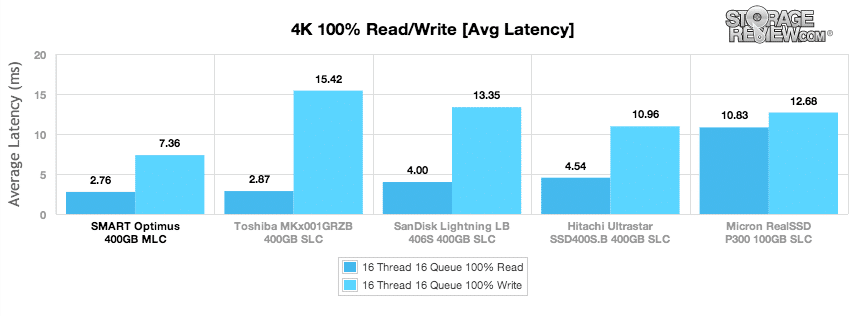
Comparing peak response times over our 100% random 4K test, the SMART Optimus had the best peak response times out of the group.
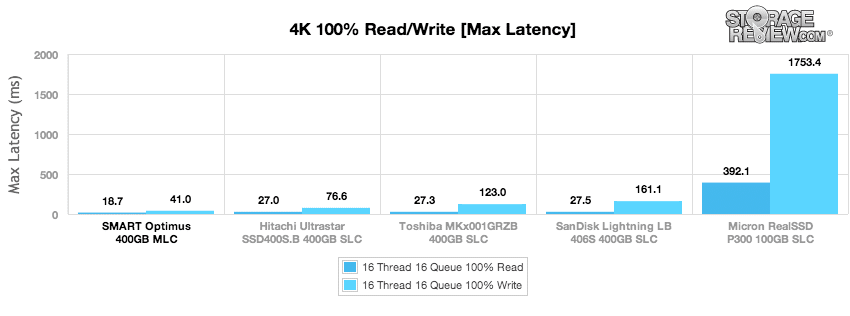
Comparing 4K random read and write standard deviation, the Optimus was very consistent, and led the pack of enterprise SLC SSDs.
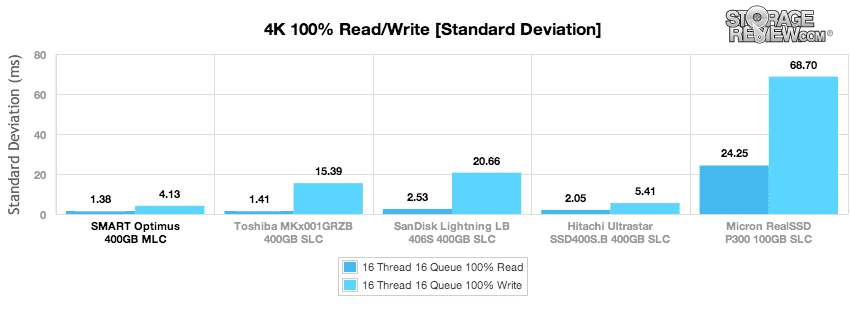
In our first mixed workload using an 8K profile with a 70% read and 30% write spread, the SMART Optimus again led the pack in throughput; this time also offering the highest burst speeds.
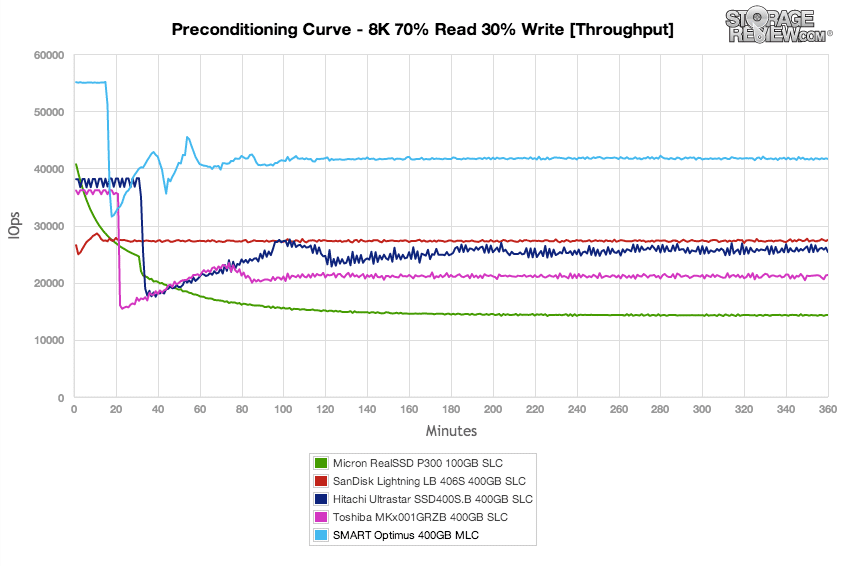
Average latency in our 8K 70/30 workload showed the SMART Optimus in a near steady-state around the two hour mark, as well as having the best responsiveness.
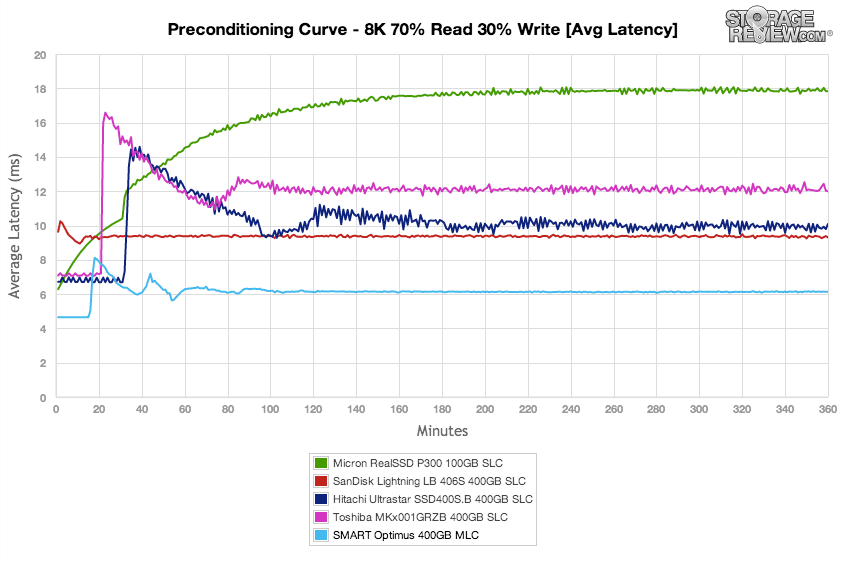
Similar to the peak latency we measured in our 100% 4K workload, the SMART Optimus again offered some of the lowest peak response times, matched only by the Hitachi Ultrastar SSD400S.B.
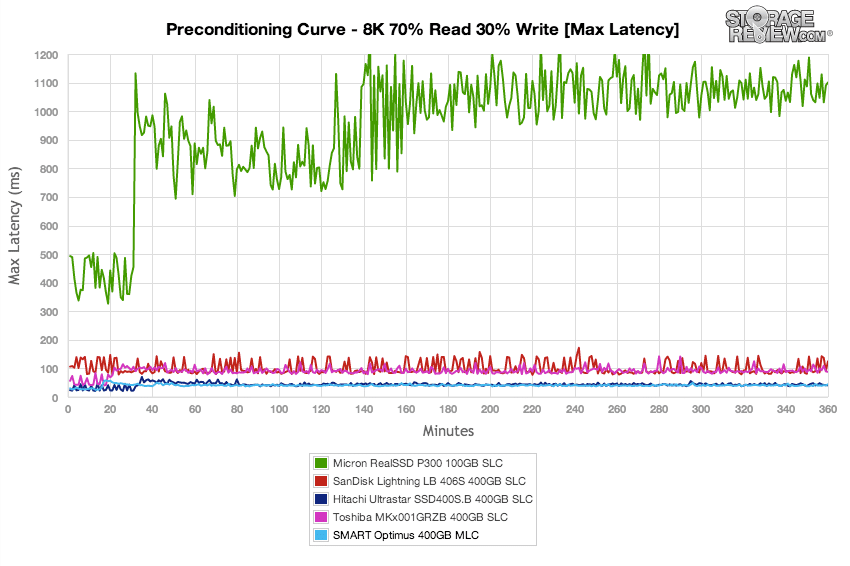
Diving in deeper to the latency standard deviation, the SMART Optimus offered the most consistent latency over the duration of our 8K 70/30 preconditioning test.
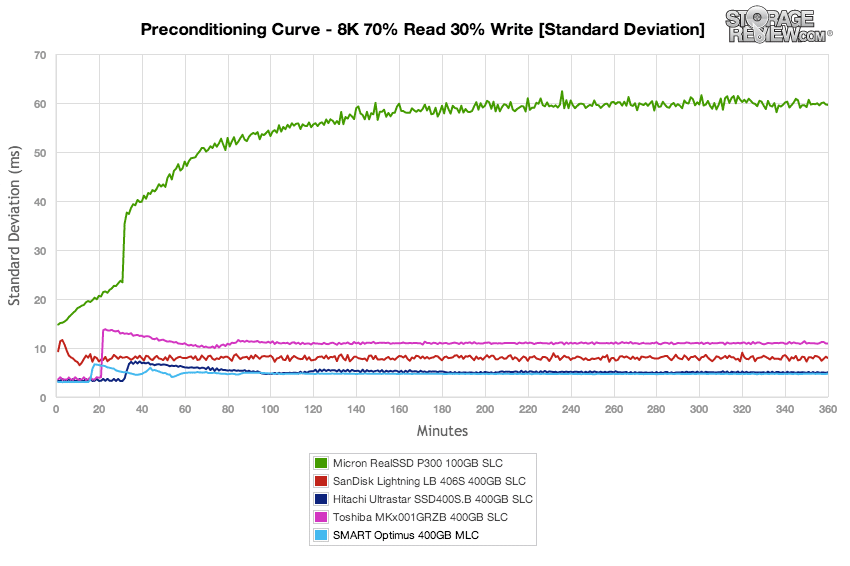
While the 100% 4K workload looked at performance in only a 16T/16Q load, our mixed workloads show how performance scales over a range of 2T/2Q to 16T/16Q. The new to market SMART Storage Systems Optimus enterprise SSD offered the highest class-leading performance we have seen to date against any other drive in the SATA/SAS MLC, eMLC, or SLC space.
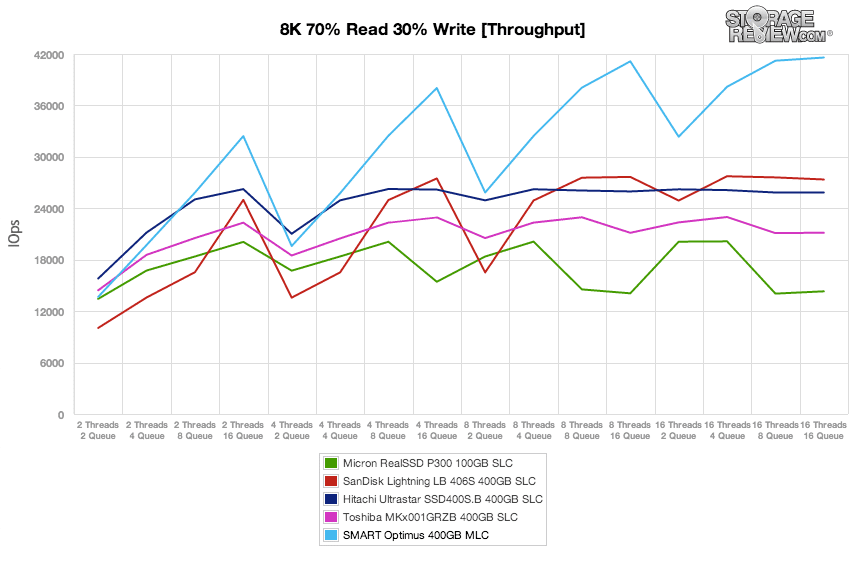
Switching our focus to average latency, the Optimus offered the best response times by far, with the exception of the lower 2T/2Q and 2T/4Q loads where the Hitachi SSD400S.B and Toshiba eSSD offered better off-the-line performance.
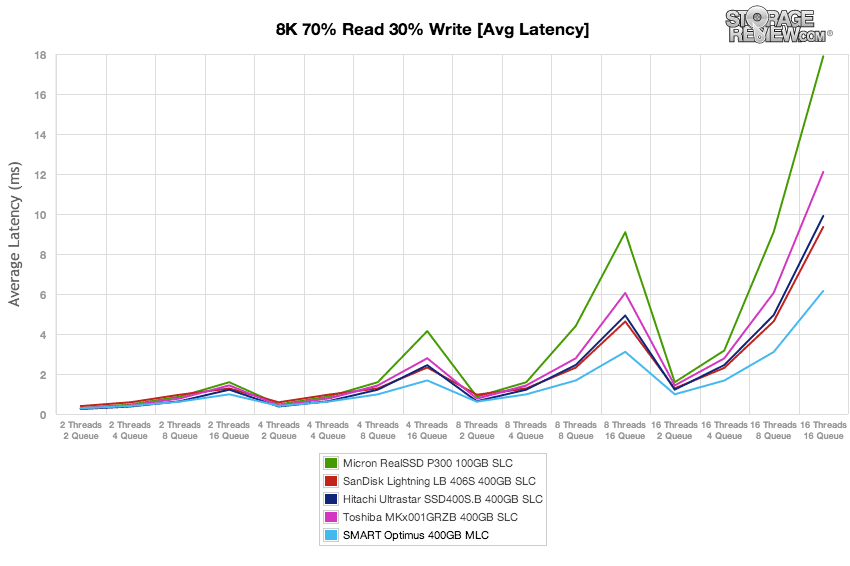
Comparing peak response times over the 8K 70/30 workload spectrum, the SMART Optimus offered the lowest maximum latency numbers, with the Hitachi SSD400S.B coming in closest.
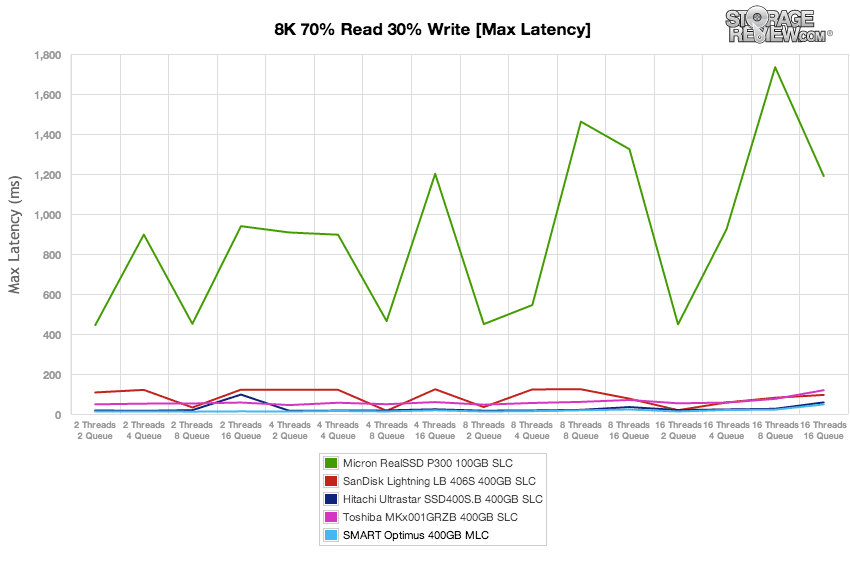
Switching our focus to latency standard deviation, the SMART Optimus lost some of its edge to the Hitachi SSD400S.B, although it still came in a very close second.
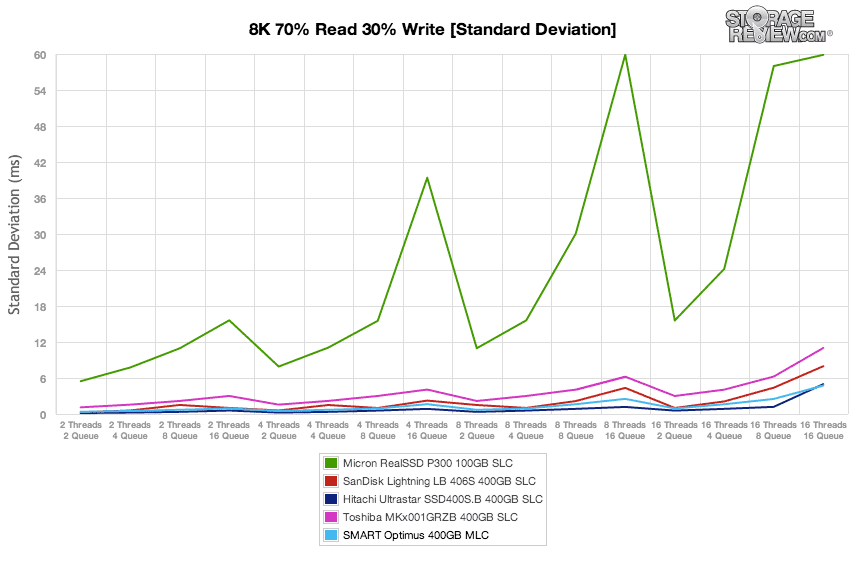
The next workload we look at is our File Server profile, which covers a wide range of transfer sizes spanning from 512b to 512K. In this section, the Optimus slips into the second-place spot for the first time beneath the SanDisk Lightning LB 406S.
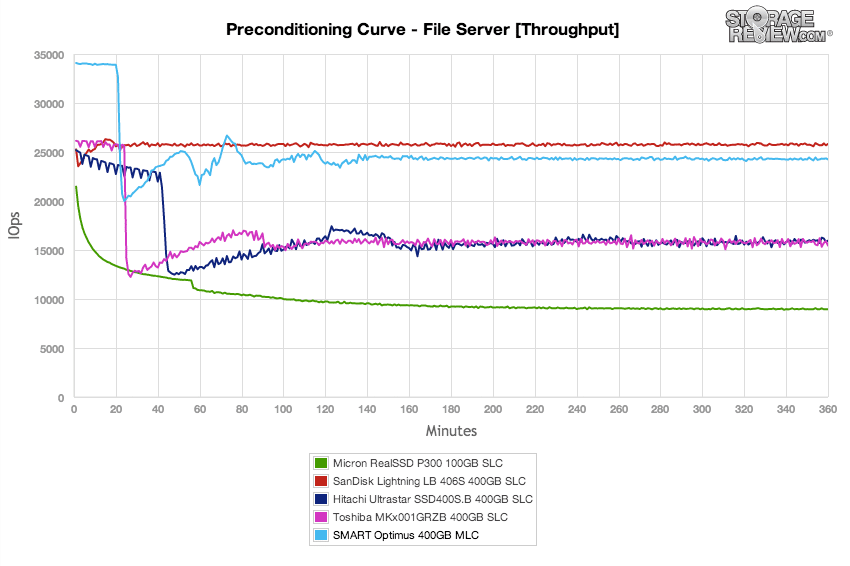
Comparing average latency in our File Server workload, the Optimus starts to level off in performance slightly past 2 hours in, versus the SanDisk Lightning which reached steady-state around 20 minutes into our preconditioning process.
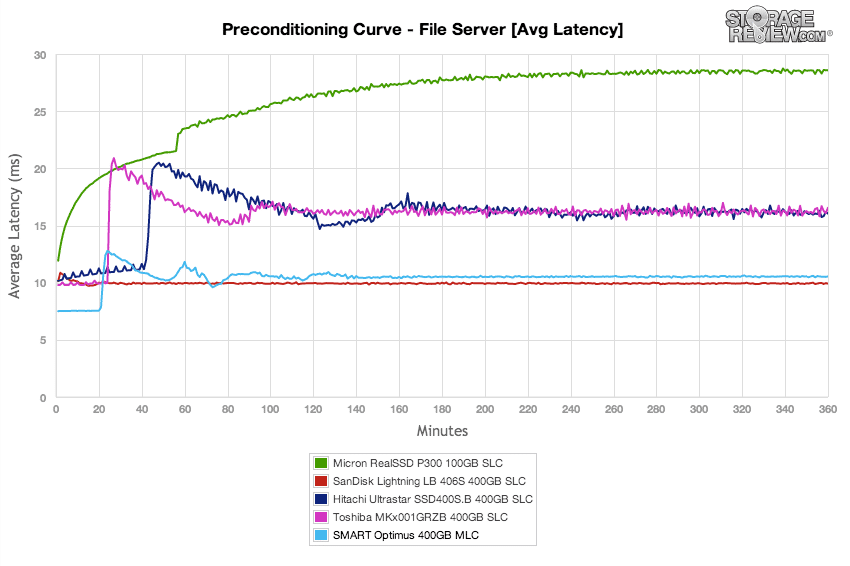
While the SanDisk Lightning LB 406S offered the fastest throughput and lowest average latency, the Optimus was able to offer slightly lower peak latency over the duration of the preconditioning process.
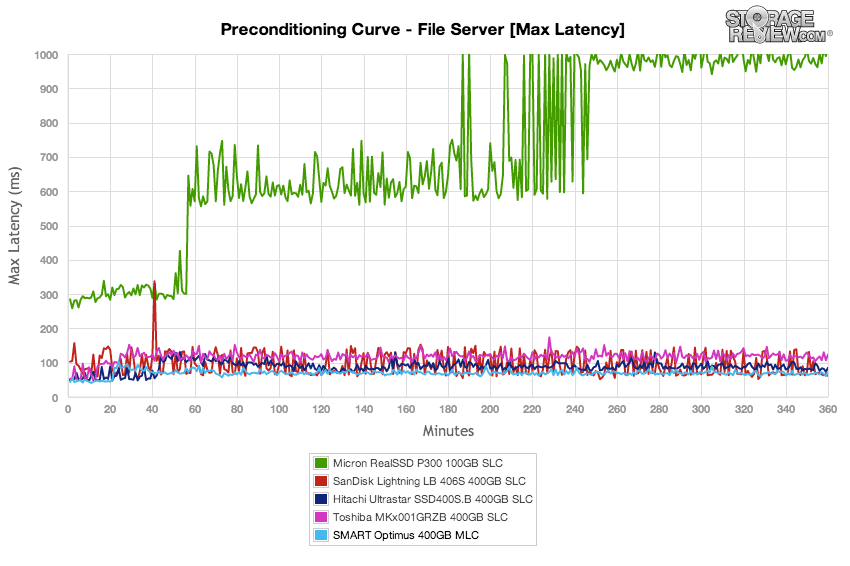
Comparing latency standard deviation in our File Server workload, while the SMART Optimus was able to had slightly lower latency peaks, its consistency came in second to the SanDisk LB 406S (and closely matched by the Ultrastar SSD400S.B) which offered the best out of the group.
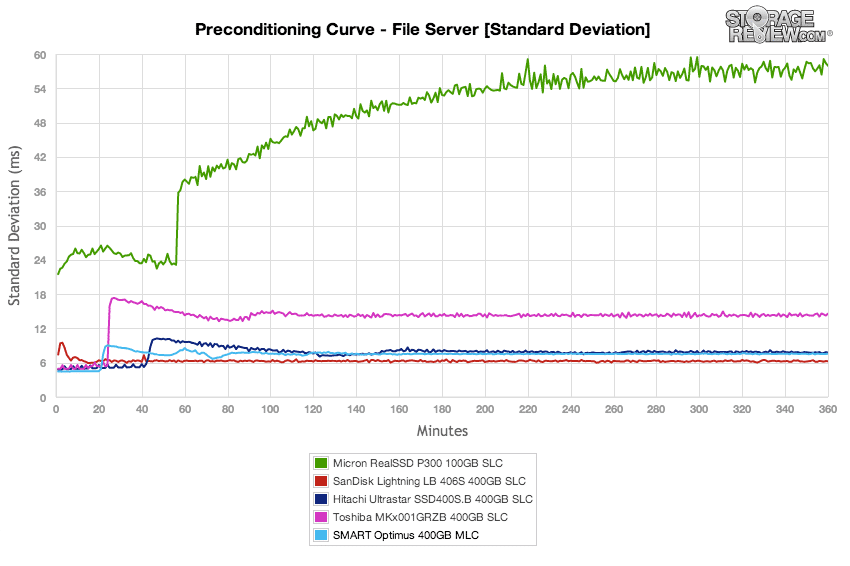
While our preconditioning phase was looking at the File Server workload with a static load of 16T/16Q, the main segment of this test varies between 2T/2Q and 16T/16Q to show how each enterprise SSD performs with a minimum to maximum saturation load. The SanDisk Lightning LB 406S offered the best performance in this category except for the 2T/2Q load, with the SMART Optimus SSD trailing close on its heels.
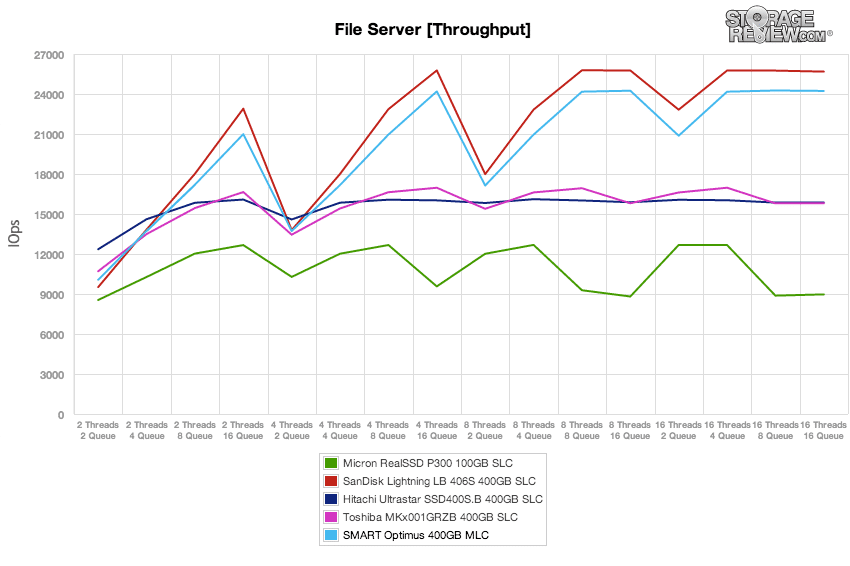
Comparing average response times, the SanDisk LB 406S and SMART Optimus stood out from the pack with very low response times, showing the most strength with heavier loading conditions.
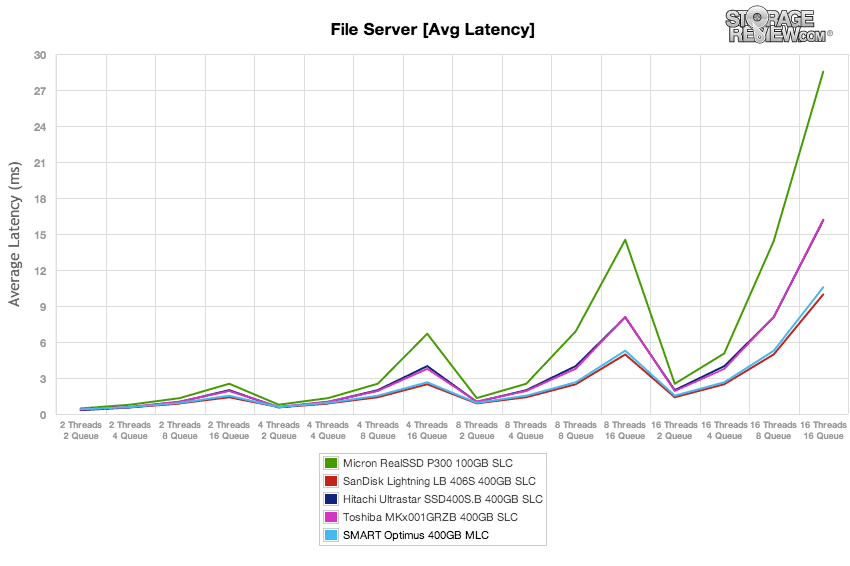
Comparing maximum latency in varying load segment of our File Server test showed the SMART Optimus and Hitachi Ultrastar SSD400S.B with the lowest latency peaks.
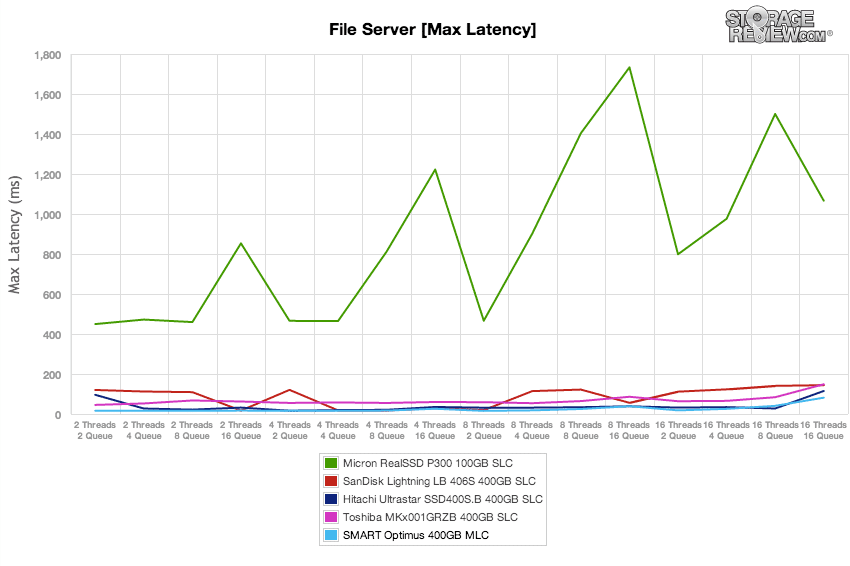
Taking a close look at latency over the duration of each test in our standard deviation measurements, the SMART Optimus slipped into third, following the SanDisk Lightning LB 406S and the Hitachi Ultrastar SSD400S.B.
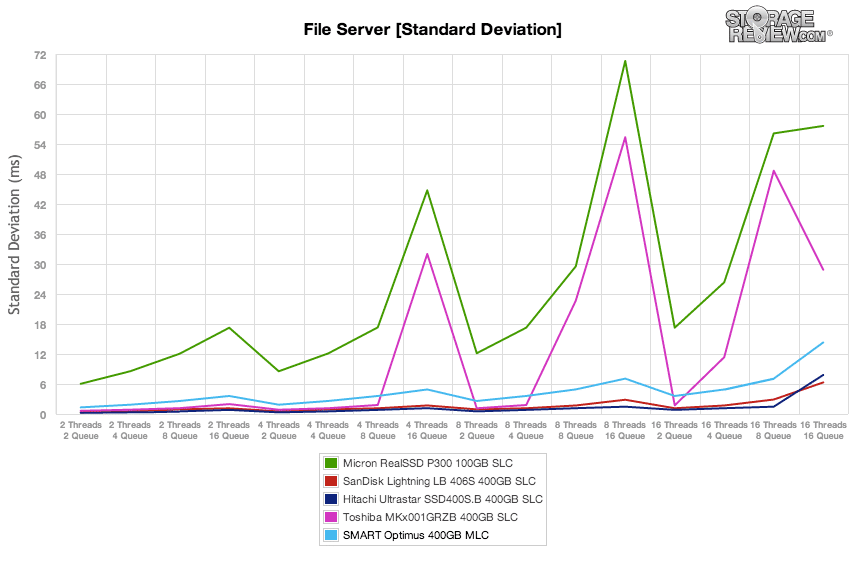
Our final preconditioning workload takes the traditionally 100% read activity Web Server test and flips it to 100% write to precondition each SSD. In this segment the SanDisk Lightning LB 406S had high throughput with the other comparables, including the Optimus coming in with much lower performance. The one area for concern that did rear its head in this segment was a large drop in performance more than three hours into the test where performance sharply dropped before recovering.
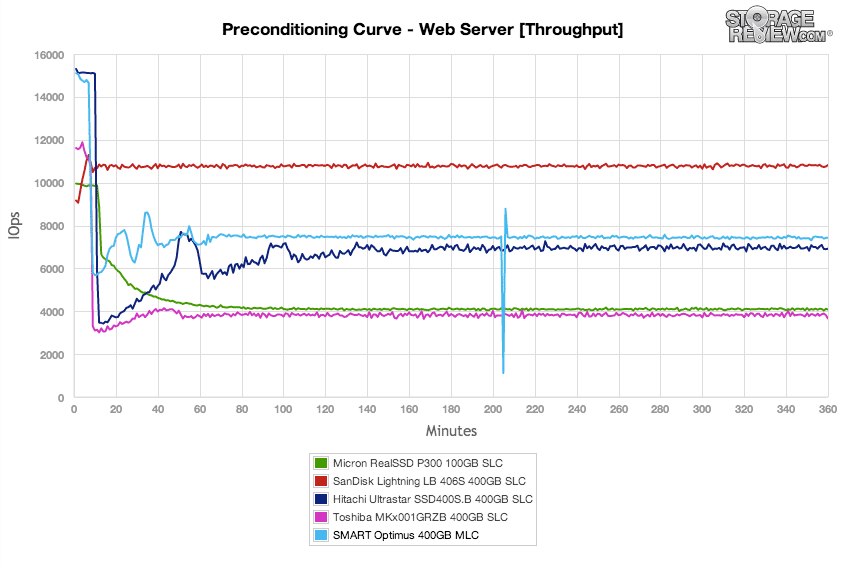
Switching to average latency in our 100% write Web Server preconditioning test, the SMART Optimus came in second to the SanDisk Lightning, although midway through the test it showed one huge latency blip.
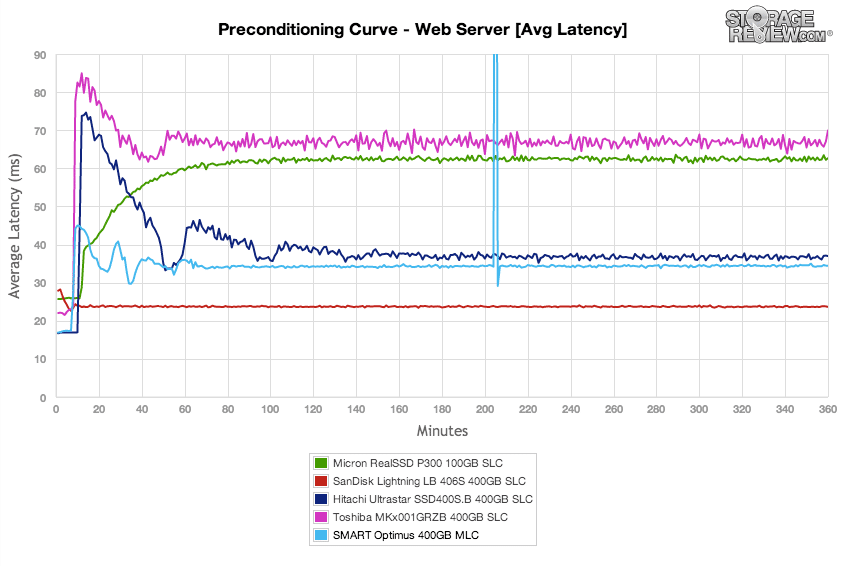
Comparing max response times, the SMART Optimus was fairly well behaved over the duration of the preconditioning phase, measuring below 250ms for most of the test. The one massive spike it did have though measured 54,689ms when it froze in one stage of our test.
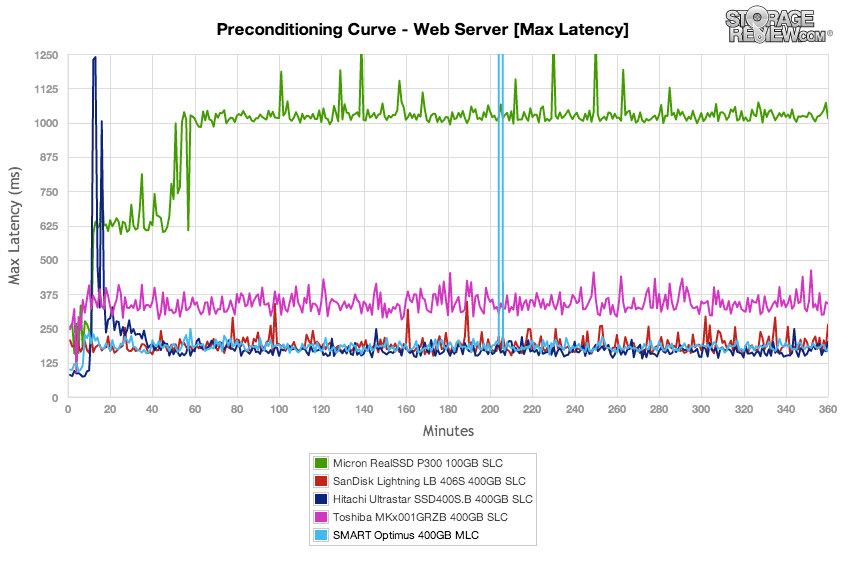
Latency standard deviation was excellent, except for the spike, for the Optimus in our Web Server preconditioning test.
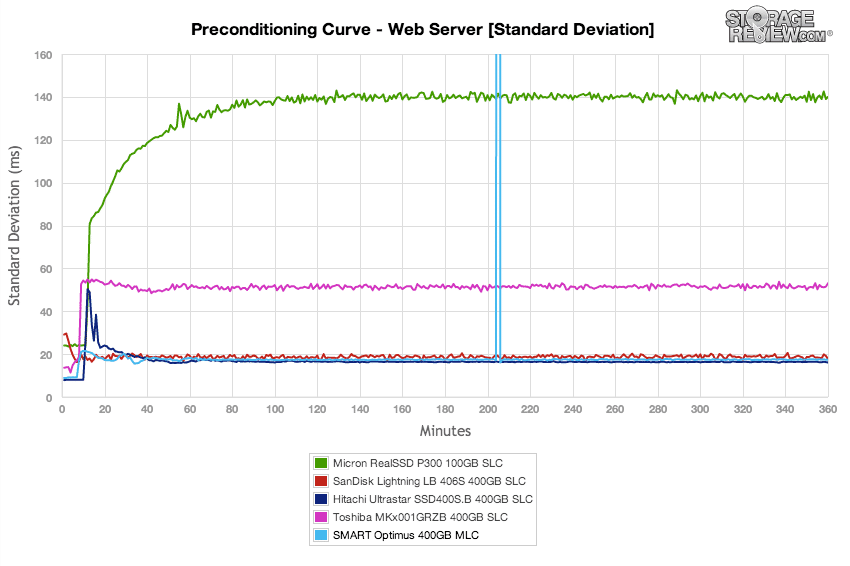
For the remainder of our Web Server test, we switch back to 100% read activity (whereas the preconditioning was 100% write). In this test, except for the lowest 2T/2Q and 2T/4Q loads, the SMART Optimus SSD offered the highest throughput, followed by the Toshiba MKx001GRZB.
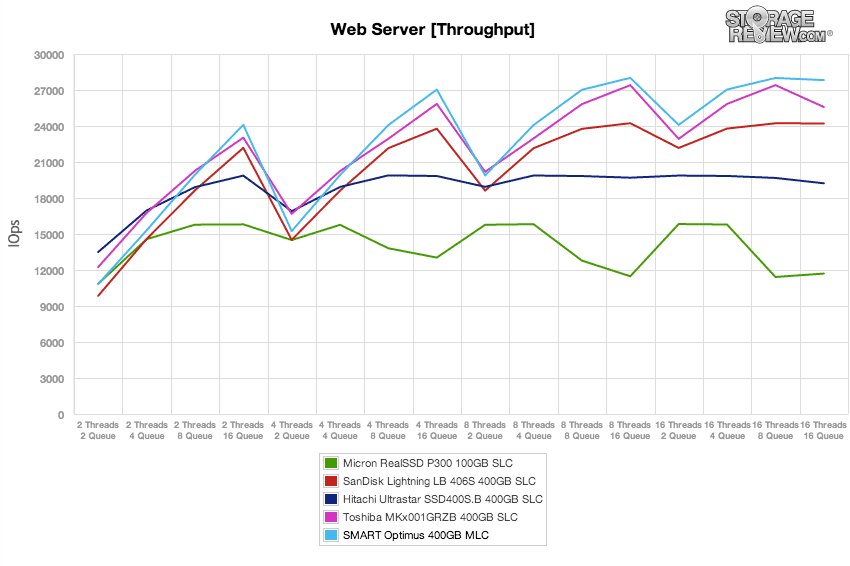
Average response times for the SMART Optimus were great in the 100% read segment of our Web Server profile, where it dominated the SLC SSD group.
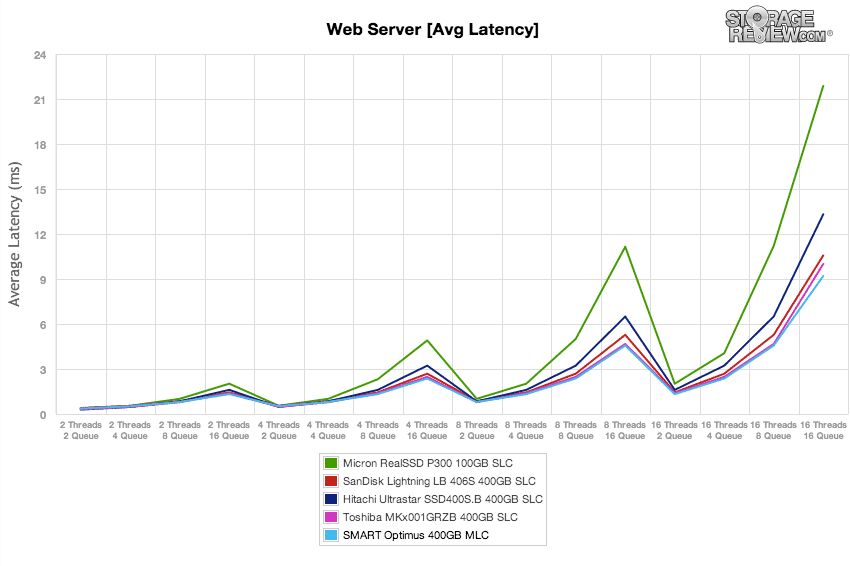
While the peak response times in the preconditioning stage of the Web Server profile could have been better for the SMART Optimus, it turned a new leaf in the 100% read segment where it came in second to the Hitachi SSD400S.B with lowest latency spikes.
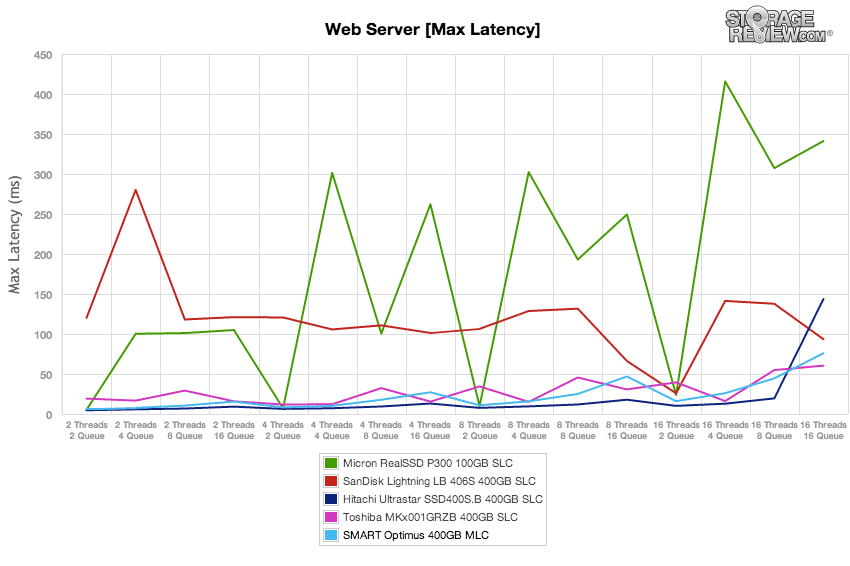
With 100% read activity being very low-impact for the SLC-based drives we tested, with the exception of the SATA-based Micron RealSSD P300 in higher loads over QD32, each drive in this group showed exceptionally consistent standard deviation. Over the course of the test, the Toshiba eSSD had a slight edge over the Optimus, although not by much.
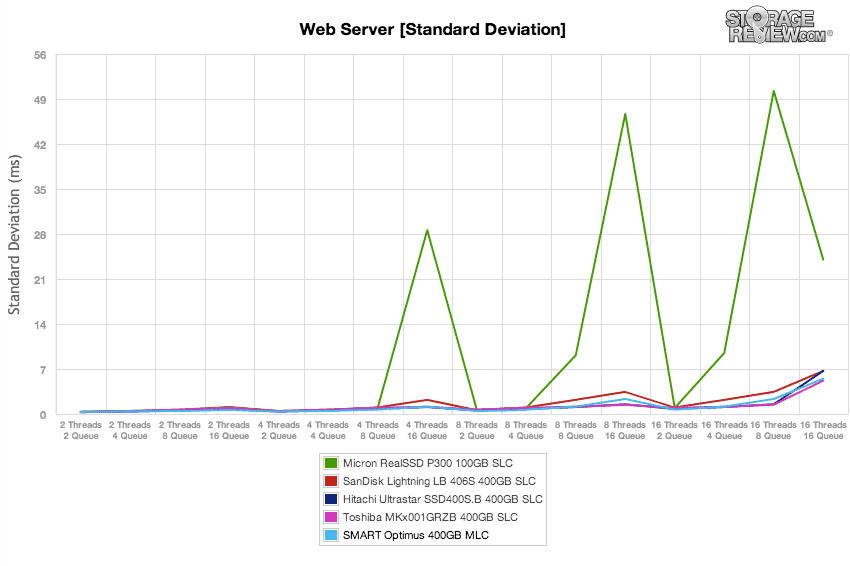
Conclusion
The SMART Storage Systems Optimus is quite the debut for a company that thus far has made its name with SandForce-driven SSDs that at times can get washed out from a performance perspective in an increasingly competitive market. To succeed, SSD vendors have to differentiate with unique IP or engineering, which is exactly what SMART has done here. While they don’t own a NAND fab, they’ve managed to create their own firmware build around a custom controller and proprietary methods for handling and addressing the NAND that let them drive tremendous endurance and performance with the Optimus.

To be fair to the intuitive MLC and eMLC based comparable SSDs, we adjusted the comps for this review to be SLC-only. And with good reason, the Optimus trounces just about every SATA or SAS drive we’ve had in the lab to date. Full disclosure, some of the SLC drives we compared have been in the market for years, but that doesn’t change the fact they’re the leading enterprise offering from big name companies that get roughed up by the Optimus. The Optimus cranks away in our benchmarks, holding the top spots in our 4K, 8K 70/30, and Web Server workloads. In areas such as the 8K 70/30 workload, performance is substantially higher than competing SLC models, including better average and peak latency.
The Optimus is not without its flaws though, where we did see a fairly large spike in latency during one of our preconditioning runs where the drive paused for nearly 55 seconds. This activity was not repeated in any other test, nor did it affect the final 100% read activity that followed the preconditioning stage. For such a new offering to the market as the first to really push consumer MLC NAND to performance and endurance levels that rivals the SLC competition, it wasn’t a huge surprise to see a blip or two in performance. We would expect most of these remaining issues to be polished off in future firmware revisions, or not even show up in most in most installations that don’t stress the drives as hard as we do.
Pros
- Very capable firmware/software stack that pushes an MLC drive beyond SLC competitors
- Extremely fast, leading the top-tier enterprise offerings in nearly all categories
- Excellent design that drives great thermal performance in a compact 9.5mm form-factor
Cons
- Large latency pause found in our Web Server preconditioning test
Bottom Line
The SMART Storage Systems Optimus offers endurance of 10 full drive writes per day over its five year warrantied life span. Solid endurance out of an MLC-based drive for sure, but even more impressive is the SLC-beating performance the Optimus provides, taking top spots in more than half of our benchmarks.


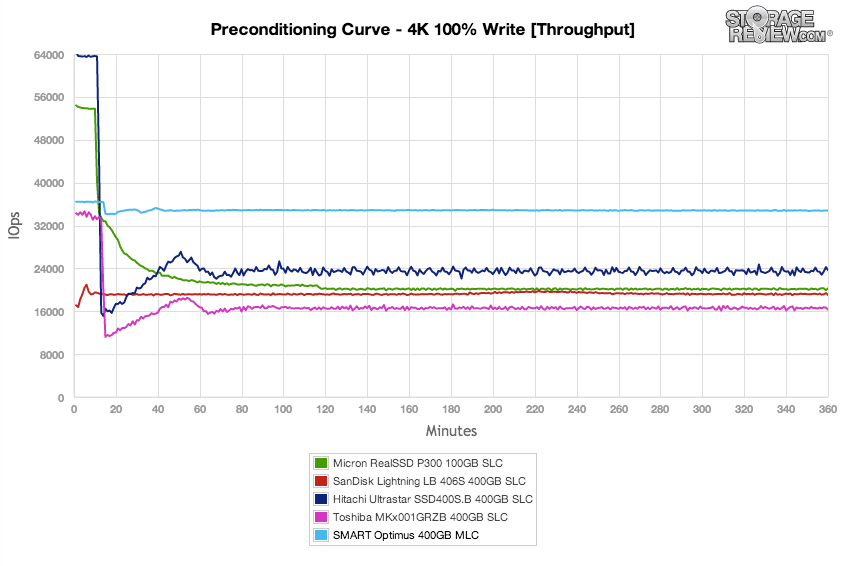
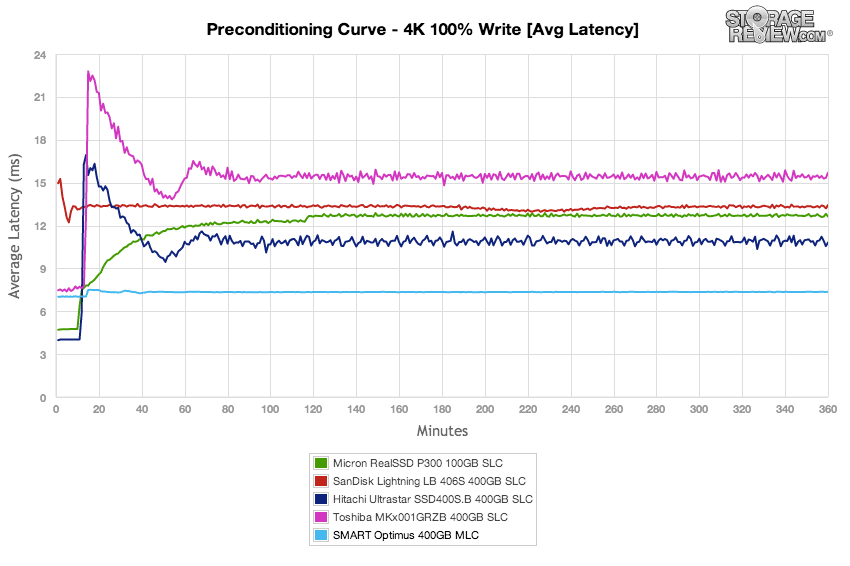


 Amazon
Amazon